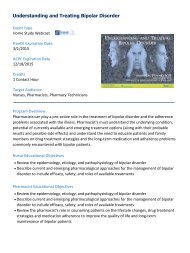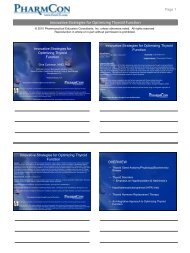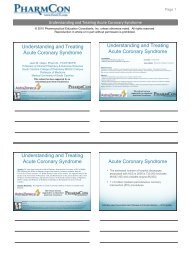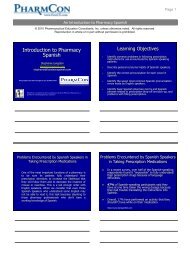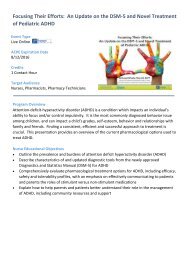A Brief Overview of Pharmacy Calculations for Pharmacy - Free CE ...
A Brief Overview of Pharmacy Calculations for Pharmacy - Free CE ...
A Brief Overview of Pharmacy Calculations for Pharmacy - Free CE ...
Create successful ePaper yourself
Turn your PDF publications into a flip-book with our unique Google optimized e-Paper software.
A <strong>Brief</strong> <strong>Overview</strong> <strong>of</strong> <strong>Pharmacy</strong><strong>Calculations</strong> <strong>for</strong> <strong>Pharmacy</strong>TechniciansRoman NumeralsRatio & ProportionDecimalsRounding NumbersSystems <strong>of</strong> MeasurementIV <strong>Calculations</strong>Rhomell Calara, PharmD, CPhKevin McCarthy, RPhCopyright PharmCon Inc 2010
A <strong>Brief</strong> <strong>Overview</strong> <strong>of</strong> <strong>Pharmacy</strong> <strong>Calculations</strong> <strong>for</strong><strong>Pharmacy</strong> TechniciansSpeaker: Rhomell Calara has built a solid reputation as Central Florida's premiere Consultant Pharmacist. Rhomell receivedhis Doctorate <strong>of</strong> <strong>Pharmacy</strong> from Nova Southeastern University in1997. After he graduated with high honors, he did a residencyin Primary Care/Ambulatory care at the Bay Pines VA Medical Center. Rhomell is currently employed by the Department <strong>of</strong>Veterans Affairs as a Clinical/Consultant Pharmacist <strong>for</strong> the Florida Department <strong>of</strong> Veterans Affairs and is currently thePresident <strong>of</strong> Consultant Pharmacists <strong>of</strong> Central Florida (http://www.ConsultantRx.com).Speaker Disclosure: Rhomell Calara has no actual or potential conflicts <strong>of</strong> interest in relation to this programThis program has been brought to you by PharmConPharmCon, Inc. is accredited by the Accreditation Council <strong>for</strong> <strong>Pharmacy</strong> Education as aprovider <strong>of</strong> continuing pharmacy education.Legal Disclaimer: The material presented here does not necessarily reflect the views <strong>of</strong> Pharmaceutical EducationConsultants (PharmCon) or the companies that support educational programming. A qualified healthcare pr<strong>of</strong>essional shouldalways be consulted be<strong>for</strong>e using any therapeutic product discussed. Participants should verify all in<strong>for</strong>mation and databe<strong>for</strong>e treating patients or employing any therapies described in this educational activity.
A <strong>Brief</strong> <strong>Overview</strong> <strong>of</strong> <strong>Pharmacy</strong> <strong>Calculations</strong> <strong>for</strong><strong>Pharmacy</strong> TechniciansAccreditation:Technicians: 0798-0000-09-094-L01-TTarget Audience: Technicians<strong>CE</strong> Credits: 1.0 Continuing Education Hour or 0.1<strong>CE</strong>U <strong>for</strong> techniciansExpiration Date: 11/17/2012Program <strong>Overview</strong>: Accurately per<strong>for</strong>ming pharmaceutical calculations is a critical component in providingpatient care in every pharmacy practice environment and a vital part <strong>of</strong> any pharmacy technicians’ duty.Although most pharmaceutical calculations are not overly difficult, they do require flawless accuracy.Correct calculations contribute as much to patient outcomes as the newest methods and guidelines <strong>for</strong>diagnosis, treatment, and prevention; and errors in calculations can turn the best attempts at optimal patientcare catastrophic. This session will present an overview <strong>of</strong> pharmacy calculations <strong>for</strong> technicians.Objectives:• Describe examples <strong>of</strong> common systems <strong>of</strong> measurement• Explain the process <strong>of</strong> percentage, ratio, and proportion and show how they apply to pharmacycalculations• Solve common pharmacy calculations using mathematical skills reviewed in this activityThis program has been brought to you by PharmCon
Introduction Speaker’s credentials and expertise orexperience in this topic. State/review the importance <strong>of</strong> basic mathin the practice <strong>of</strong> pharmacy
Program ObjectivesDefine the common systems <strong>of</strong> measurementExplain the process <strong>of</strong> percentage, ratio, andproportion and show how they apply topharmacy calculationsBe able to solve practical problems usingmathematical skills discussed in this talk
Roman Numerals Used in writing prescriptions. Used to specify the amounts <strong>of</strong> ingredientsor quantity to be dispensed. Used in the directions to the patient.
Roman Numeral Symbolsss = one-halfI = oneV = fiveX = tenL = fiftyC = one hundredM = one thousand
Roman Numerals Three Cardinal Rules:#1 If a symbol follows another symbol <strong>of</strong>equal or greater value, the two symbols areadded together#2 If a symbol follows another symbol <strong>of</strong>lower value, the lower value is subtractedfrom the higher valuess= one-halfI = oneV = fiveX = tenL = fiftyC = onehundred#3 First per<strong>for</strong>m any necessary subtraction,then add the resulting values together to getthe final answer
Roman NumeralsQUESTION 1: IX = ?QUESTION 2: CXXII = ?QUESTION 3: 20 = ?
Roman NumeralsQUESTION 1: IX = 9QUESTION 2: CXXII = 122QUESTION 3:20 = XX
Roman Numerals - Real Life
Ratio and Proportion Proportions will be your most used pharmacycalculation Solve most dosage calculations Numerous applications in everyday life Used when two expressions are directly related toone anotherFor instance, if 1 kg <strong>of</strong> drug cost us $5, how much2 kg cost?both expressions contain cost per weightif they are set up as ratios, once the problem issolved, both ratios should be equalwill
Ratio and ProportionA ratio is the relation between like numbersor values, or a way to express a fractionalpart <strong>of</strong> a whole. Ratios may be written: As a fraction: 2/3 With the ratio or colon sign: 2:3 Using "per": 2 milliliters per 3 hours(2ml/3hr)
Ratio and ProportionThe strength or concentration <strong>of</strong> various drugs canbe expressed as a ratio. First, read the label <strong>of</strong> thedrug and find the strength or concentration.Express this strength as a ratio in fractional <strong>for</strong>m,as in the following examples:Tolnaftate solution, 10 mg per ml = 10 mg/1 mlKanamycin injection, 1.0 gm/3 ml = 1.0 gm/3 mlIsoproterenol inhalation, 1:200 = 1/200
Ratio and ProportionA proportion consists <strong>of</strong> two equal ratios andis essentially a statement <strong>of</strong> equalitybetween two ratios. For example:2 4--- = ---5 10
Ratio and ProportionExample 2.You have a 10-ml vial <strong>of</strong> aminophyllinelabeled "25 mg per ml".How many milliliters must be injected toadminister a dose <strong>of</strong> 125 mg?
Ratio and ProportionExample 1.You have a 10-ml vial <strong>of</strong> aminophylline labeled "25 mg per ml".How many milliliters must be injected to administer a dose <strong>of</strong>125 mg?25 mg 125 mg-------- = -----------1 ml X ml25mg (X) = (1 ml) (125 mg)X = 5 ml
Ratio and ProportionExample 2. How many milliliters must be injectedfrom an ampule <strong>of</strong> Prochlorperazine labeled "10mg/2 ml" in order to administer a dose <strong>of</strong> 7.5 mg?
Ratio and ProportionExample 2. How many milliliters must be injected from anampule <strong>of</strong> Prochlorperazine labeled "10 mg/2 ml" in orderto administer a dose <strong>of</strong> 7.5 mg?10 mg 7.5 mg-------- = -----------2 ml X ml10mg (X) = (2 ml) (7.5 mg)X = 1.5 ml
Ratio and ProportionA <strong>for</strong>mula calls <strong>for</strong> 42 capsules <strong>of</strong>300mg <strong>of</strong> drug. How many milligramswould be required to make 24capsules?
Ratio and ProportionA <strong>for</strong>mula calls <strong>for</strong> 42 capsules <strong>of</strong> 300mg <strong>of</strong> drug. Howmany milligrams would be required to make 24capsules?300mg = x 7,200 = 171.4 mg42 caps 24 caps 42
Ratio and Proportion – RealLifeOne person's error killed Elisha Crews Bryant,hospital <strong>of</strong>ficials said:“a miscalculation overdosed the pregnant 18-yearoldwith a magnesium sulfate meant to slow herlabor. She got 16 grams when she should havegotten 4 grams. The young mother began havingtrouble breathing, went into cardiac arrest andcould not be revived.”
Ratio and Proportion – RealLife Patient received 16 gms Mag. Sulfate, fataldose. Patient should have received 4 gms.How many ML @ 25 gm/50 ml should shehave received?
Ratio and Proportion – Real Life How many ML @ 25 gm/50 ml should shehave received to obtain 4 gms??25 gm 4 gm-------- = -----------50 ml X ml25gm X = 200 gm/mlX = 8 ml
Percentage PreparationsThree types <strong>of</strong> percentage preparations• Percent weight-in-weight (wt/wt)X Grams / 100 Grams• Percent volume-in-volume (v/v)X Milliliters / 100 Milliliters• Percent weight-in-volume (wt/v)*X Grams / 100 MillilitersMost Common
Percentage Preparations Example 1. How much Potassium Chloridein grams is needed to prepare a 1 Litersolution <strong>of</strong> 3% KCl solution?
Percentage Preparations Example 1. How much Potassium Chloridein grams is needed to prepare a 1 Litersolution <strong>of</strong> 3% KCl solution?Answer: 3% = 3 grams / 100mls1 Liter = 1000 mlsNext: 3 grams X grams---------- = -----------100 mls 1000 mlsFinally: x = 30 grams
Decimals–Three general rules when workingwith decimals#1 Never leave a decimal point “uncovered”- too easy to misread and make a mistake#2 Unless working with money, Never add zeros to the right <strong>of</strong> thedecimal point-the end signifies the accuracy <strong>of</strong> the number#3 The answer you get can be only as accurate as the least accuratenumber used in the calculation
Rounding Numbers–If the number following the place you arerounding to is 5 or higher, you round up–If the number following the place you arerounding to is 4 or lower, you round down
Try some rounding10.359 to tenths10.40.143 to hundredths0.149.9982 to thousandths9.998
Systems <strong>of</strong> MeasurementTHREE SYSTEMS–Avoirdupois-(household system)–Metric–Apothecary-(rarely used)
Metric SystemCONVERSION FACTORSMicro – one millionthMilli – one thousandthCenti – one hundredthDeci – one tenthKilo – one thousand
Avoirdupois Conversion Factors3 tsp = 1 tbsp2 tbsp = 1 oz16 oz = 1 pt2 pt = 1 qt4 qt = 1 G16oz = 1 lb
Conversion Factors Between Systems1 tsp = 5 ml1 tbsp = 15 ml1 oz = 30 ml (29.57ml)1 pt = 480 ml (473ml)1 G = 3840 ml(3784ml)1 g = 15.4 gr1 gr = 60 mg (64.8mg)1 kg = 2.2 lb1 lb = 454 g1 oz = 30 gm
Conversions6.3 oz = ? mlArrange the units so they will cancel and solveValue x Conversion Factor = Answer6.3 oz x 30ml = 189 ml1ozThe units <strong>of</strong> ounces cancel, and you are left with milliliters
ConversionYou receive a prescription <strong>for</strong> Cefzil250mg/5mls with directions to take 1teaspoonful by mouth twice daily <strong>for</strong> 10days.• How much drug in milligrams, is in oneteaspoonful?• How much Cefzil in milliliters do you haveto give the patient to last the full 10 days?
Parenteral (IV) <strong>Calculations</strong> Parenteral calculations deal withadministration <strong>of</strong> IV fluids Two main concepts you will learn- Flow Rate- Dose per Time
Flow Rate <strong>Calculations</strong> Flow rate is the speed at which an IV solutionis delivered Function <strong>of</strong> Volume per Time- usually reported in milliliters per hour The magical <strong>for</strong>mulavolume ÷ time = flow rateAlways be sure which time and volume units you are being asked tosolve <strong>for</strong>Is it ml/min ? Or l/hr? Something else?
Flow Rate <strong>Calculations</strong>A patient receives 1 L <strong>of</strong> IV solution over a 3 hour period.Calculate the flow rate in ml/hr.Note: the volume given is in liters, but the answer asks <strong>for</strong>milliliters. If the conversion wasn’t so obvious, we would firstneed to do a conversion <strong>of</strong> L ml.volume ÷time = flow rate1000 ml ÷ 3 hours = 333 ml/hr
Another Rate ProblemA patient receives 0.75L <strong>of</strong> IVsolution over a 4 hourperiod. Calculate the flowrate in ml/hr
Another Rate ProblemA patient receives 0.75L <strong>of</strong> IV solution over a 4 hourperiod. Calculate the flow rate in ml/hrNow the conversion is a bit harder, so we do the math0.75 L x 1000ml = 750ml1 1L750 ml ÷ 4 hours = 188 ml/hr
Solve <strong>for</strong> Time By manipulating the rate <strong>for</strong>mula, we cansolve <strong>for</strong> time The equation becomes:volume ÷ rate = time
Solving <strong>for</strong> TimeIf an IV is run at 125ml/hr, how longwill 1 L last?
Solving <strong>for</strong> TimeIf an IV is run at 125ml/hr, how long will 1 L last?volume ÷ rate = time1000 ml = 8 hours125ml/hrMilliliters cancel and you are left with the units <strong>of</strong> hours
Solving <strong>for</strong> Volume Play with the <strong>for</strong>mula some more, and nowwe can solve <strong>for</strong> volume The equation becomes:rate x time = volume
Solving <strong>for</strong> VolumeHow many ml <strong>of</strong> IVsolution would berequired to run anIV <strong>for</strong> 12 hours at arate <strong>of</strong> 60 ml/hr?
Solving <strong>for</strong> VolumeHow many ml <strong>of</strong> IV solution would be required to run an IV<strong>for</strong> 12 hours at a rate <strong>of</strong> 60 ml/hr?rate x time = volumeIT’S REALLY JUST A CONVERSION PROBLEM!60 ml x 12 hr = 720 ml1hr 1
Solving <strong>for</strong> VolumeWhat volume would we need to have onhand if an IV solution is to be run <strong>for</strong> 100ml/hr <strong>for</strong> 8.3 hrs?
Solving <strong>for</strong> VolumeWhat volume would we need to have on hand if anIV solution is to be run <strong>for</strong> 100 ml/hr <strong>for</strong> 8.3 hrs?100 ml x 8.3 hr = 830 ml1 hr
Any Questions?ARE YOU READY FOR THE“PHARMACYTECHNICIAN MATHCONTEST”ON-LINE COMPETITION!
This is Pope John the 22 nd , whatwould that be in Roman Numerals?
This is Pope John the 22 nd , whatwould that be in Roman Numerals?Pope John XXII
Question: What number super bowlis illustrated below, and, what teamwon the game?
Question: What number super bowlis illustrated below, and, what teamwon the game?Super Bowl 43, won bythe Pittsburgh Steelers
What is the sum <strong>of</strong>XLVI + IXin Roman Numerals?
What is the sum <strong>of</strong>XLVI + IXin Roman Numerals?46 + 9 = 55 or LV
• If a customer asked to buy 10 packages <strong>of</strong>Sudafed, containing 20 tablets <strong>of</strong> 30 mgPseudoephedrine, how many milligrams <strong>of</strong>Pseudoephedrine is she purchasing?• Why would she want so much Sudafed?
• If a customer asked to buy 10 packages <strong>of</strong> Sudafed,containing 20 tablets <strong>of</strong> 30 mg Pseudoephedrine, howmany milligrams <strong>of</strong> Pseudoephedrine is he purchasing?10 Packs X 20 Tabs X 30 mg = 6000 mg• Why would she want so much Sudafed?– Key ingredient in the making <strong>of</strong>methamphetamine
• Your customer now has 6000 mg <strong>of</strong>Pseudoephedrine. If it takes 1800 mg <strong>of</strong>Pseudoephedrine to make 6 gm <strong>of</strong> crystalmeth, how many grams can she make?
• Your customer now has 6000 mg <strong>of</strong> Pseudoephedrine. If ittakes 1800 mg <strong>of</strong> Pseudoephedrine to make 6 grams <strong>of</strong>crystal meth, how many grams can she make?1800 mg PSE 6000 mg PSE----------------- = ---------------------6 gm Crys Meth X gm CrysMeth(1800mg PSE)( X )=( 6000 mg PSE)(6gm CryMeth)1800 mg X = 36000 mg/gmX = 20 gm
• Your Meth addict now has 20 gm <strong>of</strong> drug.• She wants to make a nasal solutioncontaining 25% crystal meth. How manyml <strong>of</strong> normal saline solution does she needto make a 25% solution?
• Your Meth addict now has 20 gm <strong>of</strong> drug.• She wants to make a nasal solutioncontaining 25% crystal meth. How manyml <strong>of</strong> normal saline solution does she needto make a 25% solution?25 gm 20 gm PSE----------------- = ---------------------100 ml X ml Saline(25 gm( X )=( 20 gm PSE)(100 ml)X = 80 ml
<strong>Pharmacy</strong> Technician Josh is travelingin Europe. He needs to fill up his rentalcar. Gas cost only $1.25 per liter.Technician Josh is excited that gas is socheap.What would the cost <strong>of</strong> gas be ingallons?Hint: 1 pint = 473 milliliters
<strong>Pharmacy</strong> Technician Josh is travelingin Europe. He needs to fill up his rentalcar. Gas cost only $1.25 per liter.Technician Josh is so excited that gas isso cheap.What would the cost <strong>of</strong> gas be in473 mlgallons?8 pint 1 liter $1.25-------- x ----------- x ---------- x --------- =$4.73 gal1 pint 1 gal 1000 ml 1 liter
Round to the nearestThousand1) 14,389 _________2) 29,610 _________3) 3,492 _________
Round to the nearestThousand1) 14,389 14,0002) 29,610 30,0003) 3,492 3,000
Round to the nearesttenth1) 0.89 _________2) 2.673 _________3) 2.57 _________
Round to the nearesttenth1) 0.89 0.92) 2.673 2.73) 2.57 2.6
What is the flow rate in ml/hr if1 liter Starbucks C<strong>of</strong>fee with100% french roast is givenover 12 hours???
83.3 ml/hr(1 liter = 1000 ml)1000 ml/12 hours = 83.3ml/hr
Try and solve this problem ;o)The Recommended dose <strong>of</strong> meperidine(demerol) is 6mg/kg/24hrs <strong>for</strong> pain. It is givenin divided doses <strong>of</strong> every 4 to 6 hours. Howmany milliliters (ml) <strong>of</strong> demerol injection (50mg/ml) should be administered to a 33 poundchild as a single dose every 6 hours?
1. The first step is to calculate the daily dose<strong>for</strong> a 33 pound child6 mg___ = ____x mg1 Kg (2.2 pounds) 33pounds*By inserting the conversion unit 2.2 pounds<strong>for</strong> 1kg in the ratio there is no need to do aseparate calculation <strong>of</strong> the number <strong>of</strong>kilograms in 33 pounds.X = 90 mg <strong>of</strong> demerol per day (24 hours)
2. The next step is to calculate the number <strong>of</strong>milliliters <strong>of</strong> demerol injection (50 mg/ml)needed <strong>for</strong> the total daily dose50mg= 90mg1 ml x ml50x = 90X = 1.8 ml every 24 hours
3. The final step is to calculate the number <strong>of</strong>milliliters to be given every 6 hours1.8 ml = x ml24 hrs 6 hrs24x = 10.8X = 0.45 ml**So there<strong>for</strong>e the amount <strong>of</strong> demerol(50mg/ml) to be administered is 0.45 mlevery 6 hours **
Any Questions?
Any Questions?



